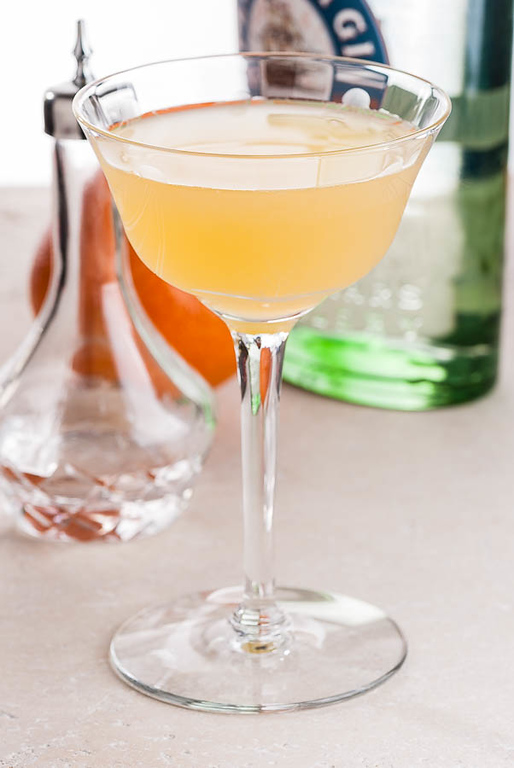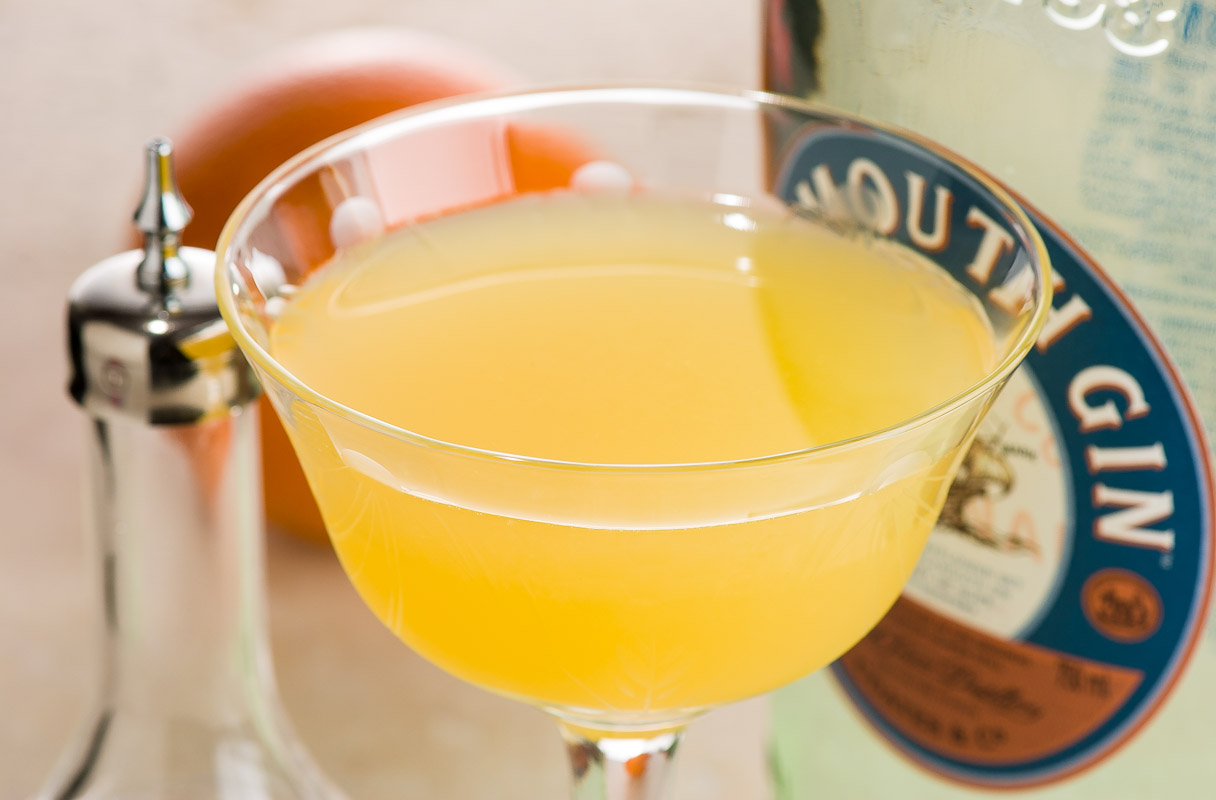Embarrassing name and all, today’s classic cocktail is the Monkey Gland.
It’s a good cocktail—in fact, it’s a delicious cocktail—but I’m trying to picture myself ordering one across a bar.
“Good evening, Miss, I’ll have a Monkey Gland, please. And keep them coming.”
Tacky.
The Monkey Gland comes from no less a promoter than Harry McElhone, of Harry’s New York Bar, in Prohibition-era Paris.
Harry was nothing if not an opportunist, and this time he was cashing in on the fame of a quack surgeon named Voronoff.
In the early 1920s, Serge Voronoff was making a fortune transplanting monkey parts into rich old men who believed the procedure would help them regain lost virility. “Experiments in rejuvenation,” as McElhone euphemistically put it. What with the desire for virility being a perennial favorite, Voronoff found lots of takers for his process. He became very rich and very famous.
So the question at hand is: would anyone other than a frat boy on a double-dog-dare order a Monkey Gland cocktail?
The answer, of course, is yes.
It seems the Parisians found Voronoff’s lurid experiments intriguing, or at least amusing, and they were perfectly willing to call for them across Harry’s bar. By 1923, McElhone’s Monkey Gland Cocktail was the rage of Paris.
Oh, well. It’s just a cocktail, might as well have some fun…

After all, McElhone’s Monkey Gland is a delicious classic, built on the “daisy” model—spirits, citrus, and fruit syrup or liqueur—complex in both flavor and aroma. Despite its lurid name, the Monkey Gland is really a relatively light gin-and-orange cocktail. Absinthe is its one notable feature; it dominates the nose, and can easily dominate the palate, too.
The Monkey Gland Cocktail
- 1½ oz dry gin (Plymouth)
- 1½ oz fresh orange juice
- 1 barspoon grenadine
- sugar to taste
- wash of absinthe or Herbsaint (Kübler) — or 2–3 dashes if you prefer to mix directly
Shake all ingredients with ice until cold; strain into a chilled cocktail stem. No garnish.
McElhone’s original called for equal parts gin and orange juice, and just a dash of absinthe and grenadine. Modernized versions stretch the gin to 2:1. I like the 1:1, but maybe that’s just because I like orange juice. The flavor seems rounder and richer at 1:1; this doesn’t seem the right drink for a gin-heavy palate.
McElhone used only a dash of absinthe, but a single dash has no presence to speak of. (This may depend on your absinthe.) I prefer a Sazerac-style wash around the inside of the glass—it boosts the absinthe’s aroma without overpowering the drink. If you mix the absinthe directly, just use 2 or 3 dashes—the other flavors are fairly laid back, and it’s easy to overrun them.
I’ve seen a couple recipes that suggest a spoon of simple syrup; it’s a good thing to keep in mind, but oranges are usually not very tart, and you can probably adjust the sweetness sufficiently with just the grenadine.
Jim Meehan (The PDT Cocktail Book) suggests that you use pomegranate molasses in the Monkey Gland, instead of grenadine. It’s an interesting suggestion, if you like pomegranate molasses. I prefer the grenadine.
Some recipes substitute Benedictine for the absinthe. This is almost certainly a response to the long-standing prohibition against absinthe, and is now beside the point. The original recipe calls for absinthe, and I recommend that you stick with it.
I can imagine McElhone putting this drink together: a simple gin-and-juice, practically a breakfast drink—sort of a potent cousin of the Screwdriver, but with the sly and scurrilous addition of absinthe to give it a dodgy, disreputable cachet. And, of course, the name.
I think he must have enjoyed his job.
But I’ll settle for making the Monkey Gland at home.
“The Monkey Gland Cocktail” at cold-glass.com : All text and photos © 2014 Douglas M. Ford. All rights reserved.

I ordered one in Mayfair and was immediately asked if I wanted the British or the American version, no blinking and no judgement. But the Brits are like that.
The British version is better (it had something like Chartreuse in it and was not sweet); I don’t recall it having Genadine, but I could be blocking.
I don’t think I’ve ever encountered a Chartreuse version of the Monkey Gland. It’s interesting that there should be a “British” and an “American” version, and well-known to your bartender that day. There’s always something more to research. Thanks for letting me know about that.
It was Benedictine – I remembered it just now. It’s not an ingredient I run into often.
Looks like really cloudy pee from someone who has not drunk any water for a while and possibly OD’d on vitamin C pills!
Sounds really delicious! Name doesn’t matter though.
Innuendo and drinking have certainly been friends for a long time. Thanks for the note.
Same thought here. Anyways, welcome. :)
It looks really delicious.
It is. Make one. Try it out.
An Australian bar near here serves a “Monkey Gland Burger”. I may order it next time. But if it turns out to be a primate’s armpit, I’m holding you responsible.
Monkey Gland Burger, I wonder how they make that? Interesting concept. Let us know how that turns out. (It’s not my fault.)
This whole post and THIS I want to know about… please tell me what is included in a monkey gland burger when its tried. I NEED to know! Ty
In stitches reading your comment. Monkeys armpit..
Ew. Just ew. I can’t even say the name without swallowing, hard. I’m sure it’s delish but I’m a pussy.
Sipping hot cocoa with a shot of Kahlua Especial doing the breast stroke across the steaming surface. Not a monkey in sight.
Reblogged this on The International Blogspaper.
what a fun drink and really enjoyed learning the backdrop, thx
Thanks for taking time to read and comment.
>
Love this blog. The cocktail glass came nearer to me when I placed my mouse pointer over it. Phew !!! I thought it came alive. Keep up the good work “the-monkey-gland-cocktail”
Thanks, and thank you for reading Cold Glass.
>
I enjoyed reading and learning from your blog. I am not a big time heavy drinker of alcohol though I have shared a glass of red wine while passing the time with a trusted friend. I may decide to like you, “operate at home” if you will, only not for myself and definitely not alone. Cheers!
Thanks! Have fun.
>
will have to give this a try. usually on a Saturday evening while watching subtitled crime!
What a great way to spend a Saturday evening. Thanks for commenting.
>
Cool
that looks awesome!! I’m more partial to vodka than gin. but looks good!
Reblogged this on thegentlemansapprentice and commented:
A lovely cocktail suggestion, with a little back-story.
Reblogged this on jothclub.
Terrific blog! The perfect combination of adventure and elegance!
Adventure and elegance! Thank you.
I think I would enjoy his job. I love a historic recipe, especially an alcohol related one. I like that it’s “dodgy, disreputable”. I too can imagine men sitting around ordering these cocktails, believing it had the power to make them more manly. Great post! I wonder if I drink it…will it make me more…Womanly?
I’m old enough to know a trick question when I see it. I think it was mostly a guy thing?
Tee hee… well… I still want to try it. I’ve had a couple run-ins with absinthe while traveling. It is an interesting beast. A couple splashes will do:)
Reblogged this on French-Style&Luxury.
Hilarious read! Gonna go home and make one =-) Congrats on getting pressed!!
Thanks, and I hope you enjoy the cocktail.
>
I’ve actually had a Monkey Gland at an Absinthe Tasting at Morton’s of Dallas. I had forgotten all about it, including that I had written about it in my old blog back in 2009! – here is a brief excerpt from my lengthy review: “they were also serving Absinthe Cocktails: Sazerac, Le Deuce, and Monkey Gland cocktails, to be exact. Monkey Gland – Monkey Gland? Yes. One wonders at the name. It is however, 2 parts Beefeater Gin, 3 parts Orange Juice, a teaspoon of Grenadine and 2 dashes Pernod Absinthe. You combine in a shaker and serve very cold. It is not good to let the monkey gland get hot.”
Anyway thanks for reminding me!
FB
“It is not good to let the Monkey Gland get hot,” that’s good and amusing advice. Thanks for the story!
mmmmmm
Reblogged this on Simply Lexi.
Reblogged this on NaturelNicole and commented:
• Interesting info!
Reblogged this on em1braga.